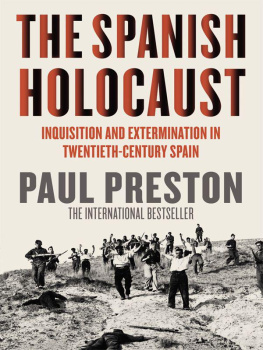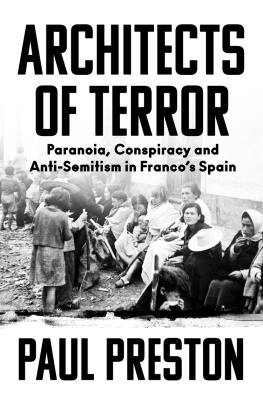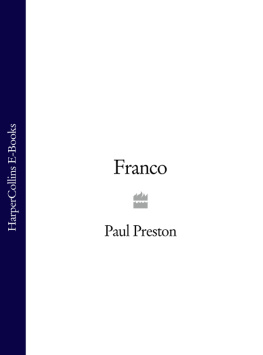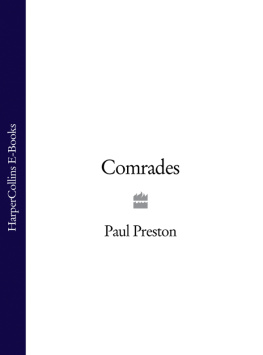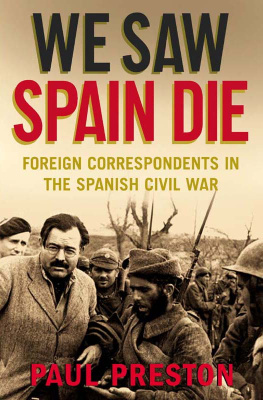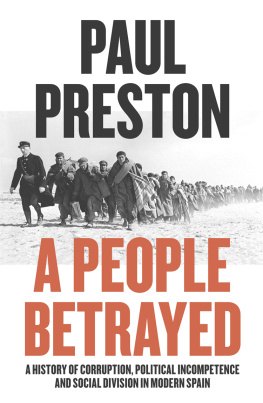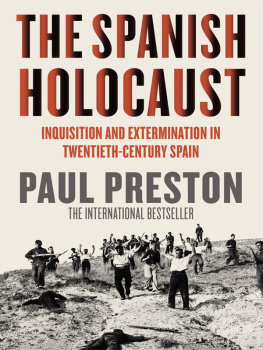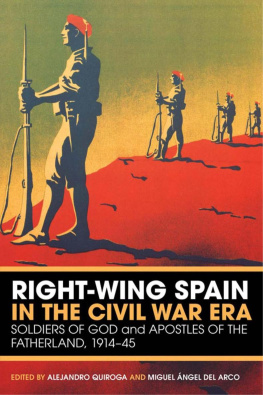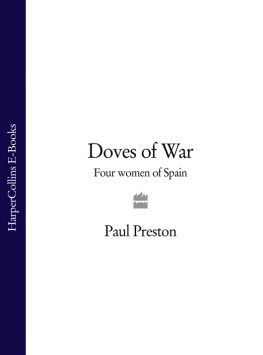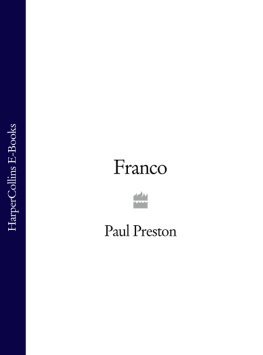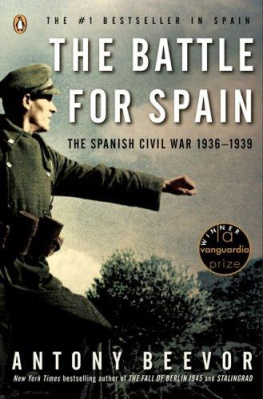CONTENTS
THE ORIGINS OF HATRED AND VIOLENCE
Social War Begins, 19311933
Theorists of Extermination
The Right Goes on the Offensive, 19331934
The Coming of War, 19341936
INSTITUTIONALIZED VIOLENCE IN THE REBEL ZONE
Queipos Terror: The Purging of the South
Molas Terror: The Purging of Navarre, Galicia, Castile and Len
THE CONSEQUENCE OF THE COUP: SPONTANEOUS VIOLENCE IN THE REPUBLICAN ZONE
Far from the Front: Repression behind the Republican Lines
Revolutionary Terror in Madrid
MADRID BESIEGED: THE THREAT AND THE RESPONSE
The Column of Deaths March on Madrid
A Terrified City Responds: The Massacres of Paracuellos
TWO CONCEPTS OF WAR
Defending the Republic from the Enemy Within
Francos Slow War of Annihilation
FRANCOS INVESTMENT IN TERROR
No Reconciliation: Trials, Executions, Prisons
The Reverberations
Franco in Seville with the brutal leader of the Column of Death, Colonel Juan Yage. ( ICAS-SAHP, Fototeca Municipal de Sevilla, Fondo Serrano )
Yages artillery chief, Luis Alarcn de la Lastra. ( EFE/jt )
General Gonzalo Queipo de Llano. ( EFE/Jalon Angel )
General Emilio Mola. ( EFE/Delespro/jt )
Gonzalo de Aguilera. ( Courtesy of Marianela de la Trinidad de Aguilera y Lodeiro, Condesa de Alba de Yeltes )
Virgilio Leret with his wife, the feminist, Carlota ONeill. ( Courtesy of Carlota Leret-ONeill )
Amparo Barayn. ( Courtesy of Ramon Sender Barayn )
A Corua, Anniversary of the foundation of the Second Republic, 14 April 1936. ( Fondo Surez Ferrn, Proxecto Nomes e Voces, Santiago de Compostela )
Jos Gonzlez Barrero, Mayor of Zafra. ( Courtesy of Gonzlez Barrero family )
Modesto Jos Lorenzana Macarro, Mayor of Fuente de Cantos. ( Courtesy of Cayetano Ibarra )
Ricardo Zabalza, secretary general of the FNTT and Civil Governor of Valencia during the war, with his wife Obdulia Bermejo. ( Courtesy of Abel Zabalza and Emilio Majuelo )
Mourning women after Castejns purge of the Triana district of Seville, 21 July 1936. ( ICAS-SAHP, Fototeca Municipal de Sevilla, Fondo Serrano )
Queipo de Llano (foreground) inspects the 5 Bandera of the Legion in Seville on 2 August 1936. ( ICAS-SAHP, Fototeca Municipal de Sevilla, Fondo Serrano )
Rafael de Medina Villalonga, in white, leads the column that has captured the town of Tocina, 4 August 1936. ( ICAS-SAHP, Fototeca Municipal de Sevilla, Fondo Serrano )
Trucks taking miners captured in the ambush at La Paoleta for execution. ( ICAS-SAHP, Fototeca Municipal de Sevilla, Fondo Serrano )
Utrera, 26 July 1936. Townsfolk taken prisoner by the column of the Legion which captured the town. ( ICAS-SAHP, Fototeca Municipal de Sevilla, Fondo Serrano )
Lorcas gravediggers. ( Courtesy of Vctor Fernndez and Coleccin Enrique Sabater )
Regulares examine their plunder. ( ICAS-SAHP, Fototeca Municipal de Sevilla, Fondo Serrano )
After a village falls, the column moves on with stolen sewing machines, household goods and animals. ( ICAS-SAHP, Fototeca Municipal de Sevilla, Fondo Serrano )
A firing squad prepares to execute townspeople in Llerena. ( Archivo Histrico Municipal de Llerena, Fondo Pacheco Pereira, legajo 1. )
Calle Carniceras (Butchery Street) in Talavera de la Reina. ( ICAS-SAHP, Fototeca Municipal de Sevilla, Fondo Serrano )
Mass grave near Toledo. ( ICAS-SAHP, Fototeca Municipal de Sevilla, Fondo Serrano )
Pascual Fresquet (centre left) with his death brigade in Caspe. ( Espaa. Ministerio de Cultura. Centro Documental de la Memoria Histrica. FC-CAUSA_GENERAL, 1426, EXP.45, IMAGEN128 )
The seizure of the Iglesia del Carmen in Madrid by militiamen. ( Espaa. Ministerio de Cultura. Centro Documental de la Memoria Histrica. FC-Causa_General, 1907, 1, p.81 )
Arms and uniforms of the Falange found by militiamen in the offices of the monarchist newspaper ABC. ( Espaa. Ministerio de Cultura. Centro Documental de la Memoria Histrica. FC-Causa_General, 1814, 1, IMAGEN6 )
Aurelio Fernndez. ( International Institute of Social History, Amsterdam, IISG-CNT )
Juan Garca Oliver. ( International Institute of Social History, Amsterdam, IISG-CNT )
ngel Pedrero Garca. ( Espaa. Ministerio de Cultura. Centro Documental de la Memoria Histrica. FC-CAUSA_GENERAL, 1547, EXP.9, IMAGEN45 )
The Brigada Garca Atadell outside their Madrid headquarters, the Rincn Palace. ( EFE/Daz Casariego/jgb )
Santiago Carrillo. ( EFE/jgb )
Melchor Rodrguez. ( EFE/Vidal/jgb )
The wounded Pablo Yage receives visitors. ( EFE/Vidal/jgb )
The cameraman Roman Karmen and the Pravda correspondent Mikhail Koltsov. ( Courtesy of Victor Alexandrovich Frandkin, Koltsov family )
Andreu Nin and Vladimir Antonov-Ovseenko. ( LArxiu Fotogrfic de Barcelona )
Josif Grigulevich, the Brigadas Especiales, Roman Karmen, then two of the NKVD staff, Lev Vasilevsky and then his boss, Grigory Sergeievich Syroyezhkin. Madrid October 1936. ( Caada Blanch Collection )
Vittorio Vidali. ( Imperial War Museum )
Refugees flee from Queipos repression in Mlaga towards Almera. ( Photograph by Hazen Sise, reproduced courtesy of Jess Majada and El Centro Andaluz de la Fotografa )
Exhaustion overcomes the refugees from Mlaga on the road to Almera. ( Photograph by Hazen Sise, reproduced courtesy of Jess Majada and El Centro Andaluz de la Fotografa )
The Regulares enter northern Catalonia January 1939. ( Espaa. Ministerio de Cultura. Centro Documental de la Memoria Histrica. FOTOGRAFIAS-DESCHAMPS, FOTO.7 )
Republican prisoners packed into the fortress of Montjuich in Barcelona, February 1939. ( Espaa. Ministerio de Cultura. Centro Documental de la Memoria Histrica. FOTOGRAFIAS-DESCHAMPS, FOTO.764 )
No military threat from those making the long trek to the French border. ( Photos 12/Alamy )
A crowd of Spanish women and children refugees cross the border into France at Le Perthus. ( Hulton-Deutsch Collection/CORBIS )
Recently arrived at Argels, women await classification. ( Roger-Viollet/Rex Features )
The male refugees are detained at Argels the only facility being barbed wire. ( Hulton-Deutsch Collection/CORBIS )
Prisoners carry rocks up the staircase at the Mauthausen-Gusen death camp. ( akg-images/ullstein bild )
Franco welcomes Himmler to Madrid. ( EFE/Hermes Pato/jgb )
Antonio Vallejo-Njera. ( EFE/jgb )
Himmler visits the psycho-technic checa of Alfonso Laurencic in Barcelona. ( LArxiu Fotogrfic de Barcelona )
Drawings made by Simon Manfield during the excavation at Valdedios, Asturias, summer 2003. ( Simon Manfield. Part of the Memoria Histrica series, simonmanfield@hotmail.com)

